
Search
The Renewable Energy site for Do-It-Yourselfers
Kevin's Way North $1K Solar Water
Heating System
|
Kevin built a version of the
$1K Solar Water
Heating system, and provides a lot of good information on 1) how he
designed and built the system, 2) well thought out changes he made to
adapt the system to his situation, and 3) the performance of the
system.
Kevin faced some unique tank
space limits and collector placement limits -- the techniques he worked
out to adapt to these limits should be helpful to people facing similar
situations.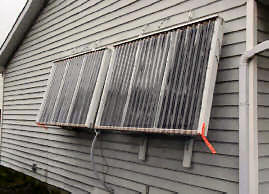
Kevin's system is located in
far nothern British Columbia at 55 degrees latitude, so it is a good
challenge for the system.
Thanks very much to Kevin for
taking the time to detail the project!
Kevin's system definitely shows the benefits of taking your time and
working carefully. |
|
Designing and Building the System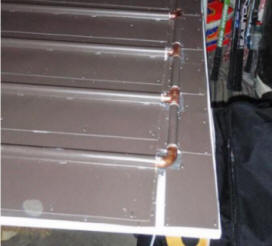
Kevin provides an excellent
description of the way in which he designed and built the system in this pdf:
Full design and construction details on Kevin's system... (pdf)
I really like the way Kevin did the
aluminum fins, and the heat exchanger is a very nice solution to the limited
inside dimensions of the tank.
Note also the pitching of the copper
pipe grid towards the center of the collector for good drain back. This is
essential for freeze protection.
System Performance
Kevin provides detailed monthly
performance plots for the periods from May 2009 to through October 2009, along
with comments on factors effecting performance, and the effect of adding an
additional collector in October.
Kevin has lots of experience in data
logging, and has set up a system to monitor and record the performance of his
system.
All the
details here...
Heat Exchanger Performance
Kevin decided to try a hybrid copper
and PEX heat exchanger. This arrangement fits his limited tank space
better than the large PEX coil that I use. The construction details are
shown in the pdf above in the Construction section.
Kevin's test of the heat exchanger
performance:
As promised, here are the two
heat exchanger tests. The pattern is very similar to yours - hot water temps
are the same as, or a degree lower than, the tank temps during the initial
emptying of the exchanger. Then the hot water temp drops in tandem with the
tank temp, staying ~2 degrees lower. At higher flows, the temp falls off,
but makes a total recovery after the rest period.
Click on images for full size
|
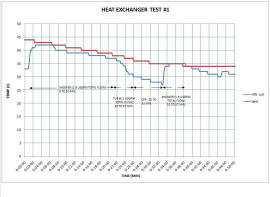
First heat exchanger test. |

2nd heat exchanger test. |
It appears to me that hybrid heat
exchanger gives very good performance -- about equivalent to the 300 ft coil of
PEX exchanger that I used -- so, there is more than one way to get the job done.
Data Logging System
Kevin describes the datalogging
system in the
construction pdf. Here is a little more detail on the hot water line
sensor that is pictured just below:
Not sure if these will stand
the test of time, but at $5 for a DS18B20 sensor vs. $47 for the only
waterproof commercial DS18B20 probe I could find online, the price is right.
The datalogging tank sensor is located at the same depth as the Steca one;
about 1/3 up from the tank bottom. I am logging at a 5 minute interval.
I installed a sensor on the
hot water line out from the exchanger. This is mainly to do an exchanger
test, but it also tells me when we are using hot water. I drilled a hole in
a 3/4" end cap and embedded a homemade probe in epoxy, then installed this
into a tee in the line (see photos). Don't worry about the hose clamp - just
temporary until I got a PEX clamp. So far so good.
Click on pictures for full size
|
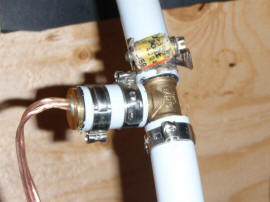
The "1-Wire" sensor mounted
in the hot water line. |
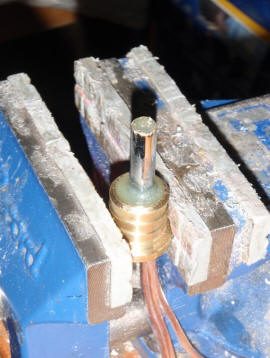
Detail of the sensor that is
epoxyed in place. |
Final Comments
This is how Kevin sums up the size of
the job -- I think that it is a very accurate assessment:
As far as building the system,
now that it's over I don't think it was that bad :) Seriously, it's
not a trivial project, but well within the average DIYer's capabilities if a
person takes it slowly and puts some care into it. It's not one of
those "hey, build this simple system and you can be saving thousands right
away" type projects that you see being hyped these days. Maybe commercial
tanks could be used, like plastic tanks that could be insulated. This might
simplify the construction.
The bottom line is that I am harnessing the power of the sun in a cost
effective and fun way!
If you have questions about the
system, Kevin provides and email address in the Construction pdf above.
Thanks again to Kevin for doing such
a great job of documenting and testing this system!!
Gary June 26, 2009, Added performance
update November 2009







